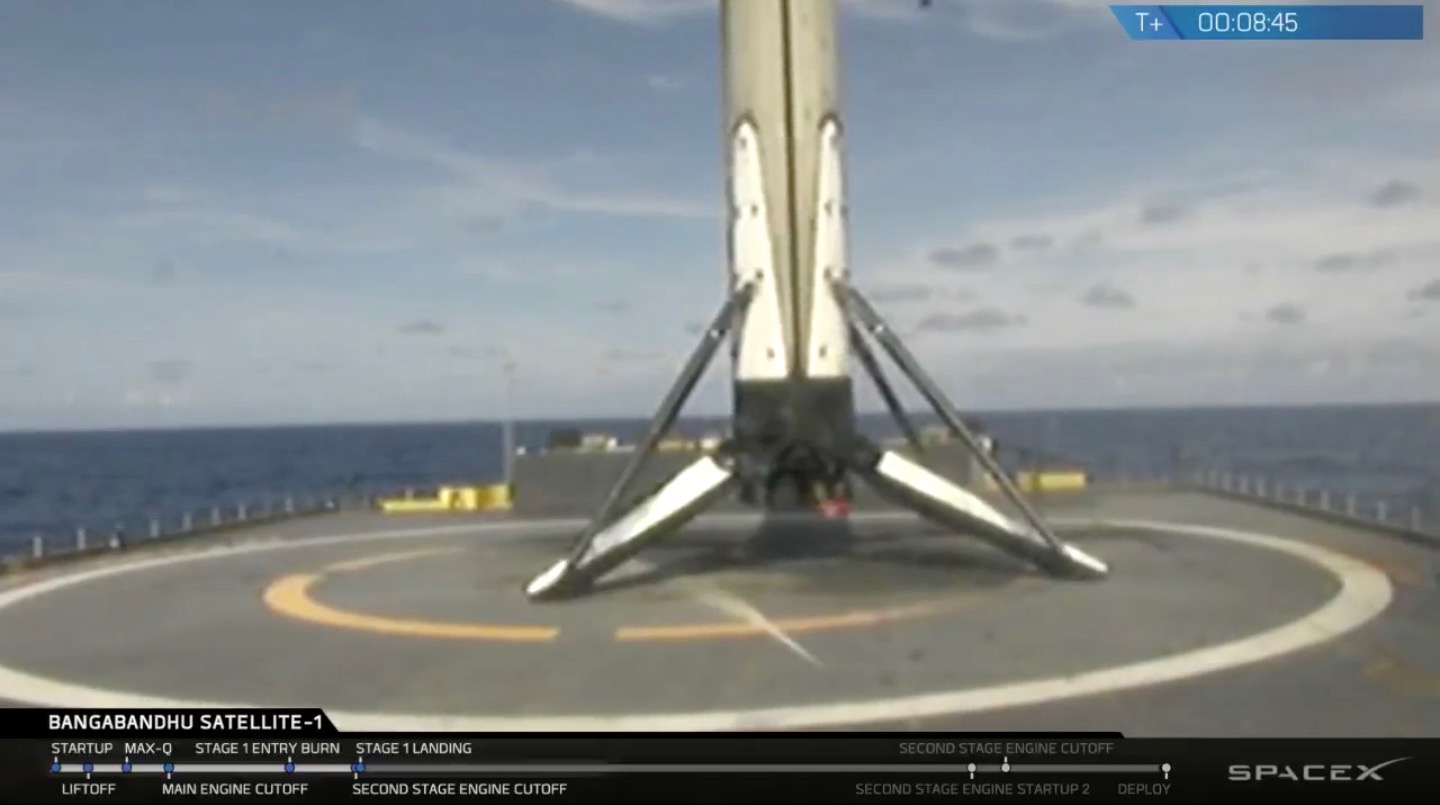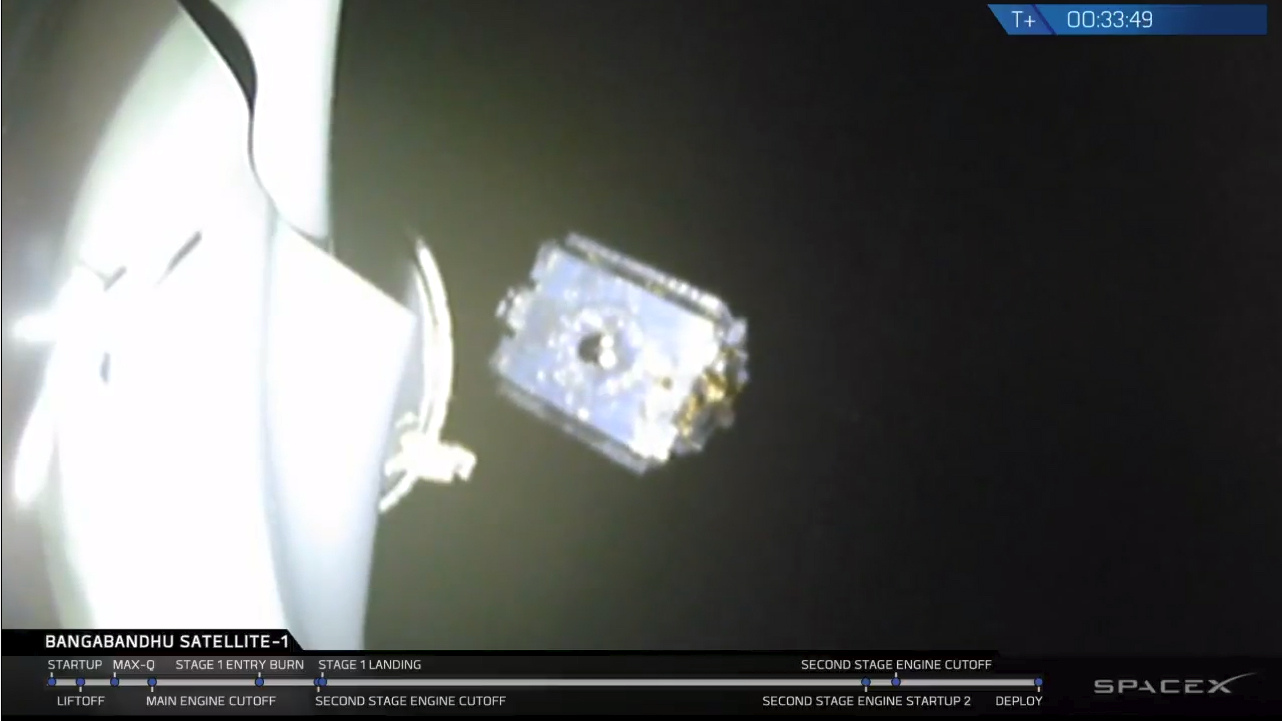SpaceX's Upgraded Falcon 9 Rocket Aces Maiden Flight, Sticks Landing
The newest, and final, version of SpaceX's Falcon 9 rocket debuted today (May 11) with a picture-perfect satellite launch — and the booster's first stage aced its landing as well.
The first-ever "Block 5" Falcon 9 vehicle launched the Bangabandhu Satellite-1, the first communications satellite for the government of Bangladesh, today at 4:14 p.m. EDT (2014 GMT), lifting off from historic Launch Pad 39A at NASA's Kennedy Space Center (KSC) in Florida.
The rocket's first and second stages separated about 2.5 minutes into the flight. As the second stage continued to power Bangabandhu-1 to a high geostationary transfer orbit, the first stage maneuvered its way back to Earth, pulling off a pinpoint touchdown on a robotic SpaceX "drone ship" stationed in the Atlantic Ocean nearly 400 miles (630 kilometers) southeast of KSC. [See the Evolution of SpaceX's Rockets in Pictures]
The landing, which occurred less than 9 minutes after liftoff, elicited raucous cheers from SpaceX employees at the company's headquarters in Hawthorne, California.
Today's launch was originally scheduled for yesterday (May 10), but a "ground system auto abort" scuttled that attempt with just 58 seconds left on the countdown clock.

Another reusability advance
Though this was the first landing for a Block 5 first stage, it was the 25th overall for a Falcon 9 during an orbital launch. To date, SpaceX has re-flown previously landed boosters 11 times.
Such activities are part of the company's efforts to develop fully and rapidly reusable rockets and spacecraft. This work is a key priority of SpaceX founder and CEO Elon Musk, who has said that such technology could slash the cost of spaceflight and make ambitious goals such as the colonization of Mars economically feasible.
Get the Space.com Newsletter
Breaking space news, the latest updates on rocket launches, skywatching events and more!
The Block 5's upgrades take another step in this direction. Boosters of previous Falcon 9 iterations have launched a maximum of two times each, but Block 5 first stages should be able to fly 10 times with just inspections between landing and liftoff, and perhaps 100 times or more with some refurbishment involved, Musk said during a pre-launch call with reporters yesterday.
The Block 5 is also more powerful than its predecessors, Musk said. The nine Merlin engines in the rocket's first stage and the single "vacuum Merlin" in the second stage boast about 8 percent and 5 percent more thrust, respectively, than their counterparts in the Falcon 9 Block 4. And this boost was achieved without an increase in mass, Musk added.
In addition, the new booster features a suite of reliability upgrades designed to satisfy NASA's stringent crew-carrying standards, because SpaceX will use the Block 5 — as well as the company's Dragon capsule— to ferry astronauts to the International Space Station (ISS).
SpaceX holds a multibillion-dollar contract with NASA to provide such taxi services. The first crewed flights of the Block 5-Dragon system could come as early as this year, SpaceX representatives have said. (NASA also signed a commercial crew deal with Boeing, which will use its CST-100 Starliner capsule and United Launch Alliance Atlas V rockets to get the job done.)
"It's really better in every way than the Block 4," Musk said, citing a range of upgrades from avionics to the thermal-protection sysem on the Block 5's first stage. "This rocket is really designed to be — the intent is to be the most reliable rocket ever built."
The Block 5 is the last version of the Falcon 9 that SpaceX will produce. SpaceX plans to eventually phase out the vehicle — along with Dragon and the just-debuted Falcon Heavy rocket — in favor of the huge rocket-spaceship combo known as the BFR, which is currently in development. The BFR will fly people and cargo to Mars, but it will also launch satellites to Earth orbit, clean up space junk, carry passengers on superfast point-to-point trips around Earth and do whatever else SpaceX needs it to do, Musk has said.
SpaceX will probably end up with a stable of 30 to 50 Falcon 9 Block 5s, which together will fly on the order of 300 missions before they're entirely superseded by the BFR, Musk said during yesterday's call.
A first for Bangladesh
The 3.9-ton (3.5 metric tons) Bangabandhu 1, which was built by French company Thales Alenia Space, will be Bangladesh's first communications satellite.
"With this historical first satellite, Bangladesh inhabitants will have access to a wide range of broadcast and communications services, including phone services, backhaul, radio, direct-to-home TV and internet," Thales Alenia Space representatives wrote in a description of the satellite.

"Once Bangabandhu Satellite-1 is operational, Bangladesh will be autonomous in terms of telecommunications and broadcasting services, being able to offer communications services to many foreign countries, such as Nepal, Myanmar or Bhutan under its coverage area," the representatives added.
The satellite is named after Bangabandhu Sheikh Mujibur Rahman, who is regarded as the founding father of Bangladesh. Rahman was a key player in the nation's push for independence, which was achieved in 1971, and served as Bangladesh's first president. ("Bangabandhu" is not part of Rahman's name but rather a title, which means "Friend of Bengal.")
Rahman was assassinated in 1975 at the age of 55.
Follow Mike Wall on Twitter @michaeldwall and Google+. Follow us @Spacedotcom, Facebook or Google+. Originally published on Space.com.
Join our Space Forums to keep talking space on the latest missions, night sky and more! And if you have a news tip, correction or comment, let us know at: community@space.com.

Michael Wall is a Senior Space Writer with Space.com and joined the team in 2010. He primarily covers exoplanets, spaceflight and military space, but has been known to dabble in the space art beat. His book about the search for alien life, "Out There," was published on Nov. 13, 2018. Before becoming a science writer, Michael worked as a herpetologist and wildlife biologist. He has a Ph.D. in evolutionary biology from the University of Sydney, Australia, a bachelor's degree from the University of Arizona, and a graduate certificate in science writing from the University of California, Santa Cruz. To find out what his latest project is, you can follow Michael on Twitter.









